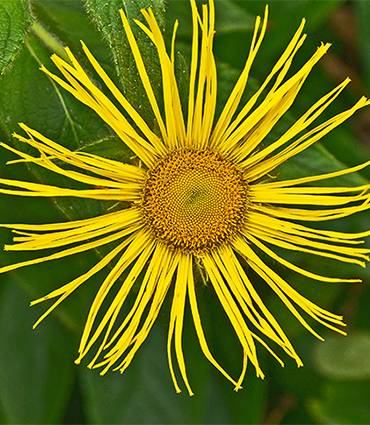Elecampane

Latin name :
Inula helenium L.
Common Name :
Elecampane, Field Snuffbox
Family :
Asteraceae
Origin :
Europe, Asia
Plant parts used :
Underground parts, flower (flower head)
Description
Elecampane, Inula helenium, is a plant of the Asteraceae family, like the daisy. According to Greek mythology, the elecampane first appeared at the place where Princess Helen (hence the term Helenium), wife of Menelaus, King of Sparta, was kidnapped by the Trojan prince Paris, which triggered the famous Trojan War. This medicinal plant is used in phytotherapy for its roots and flowers. The flowers contain sesquiterpene lactones, in particular alantolactone and santamarin, molecules with antibacterial, antifungal and detoxifying properties.
Elecampane is also composed of inulin, a polysaccharide which gives it a tonic action. In addition, the bitter principles of this plant help to stimulate the appetite. Elecampane also has diuretic, expectorant, mucolytic and antitussive properties. This is why this plant is recommended in cases of chronic and irritating coughs.
Its anti-inflammatory action promotes better respiratory comfort, especially in the bronchial tubes. This plant also acts as an anti-allergic and pulmonary antispasmodic. Moreover, elecampane has a protective action on the liver and kidneys.
The benefits
Traditionally used to facilitate digestion, elecampane contributes to the drainage of the body. Moreover, it facilitates expectoration and contributes to an adequate and easy breathing while softening the throat.
Scientific publications
Elecampane is teh object of more than 30 scientific publications.










